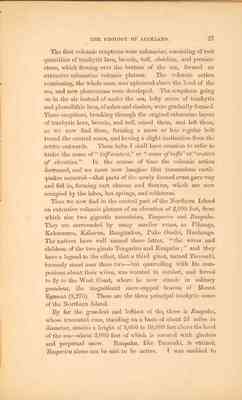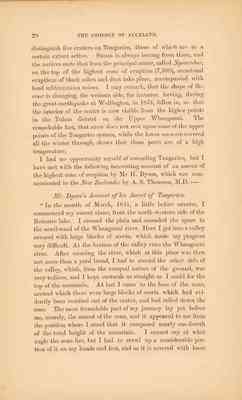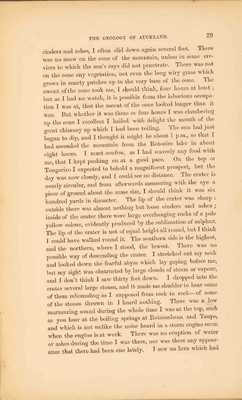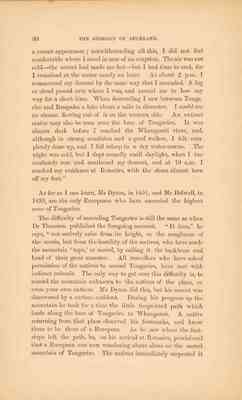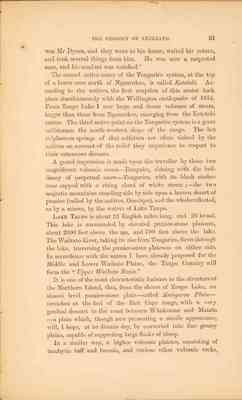Pages
THE GEOLOGY OF AUCKLAND. 27
The first volcanic eruptions were submarine, consisting of vast quantities of trachytic lava, breccia, tuff, obsidian, and pumicestone, which flowing over the bottom of the sea, formed an extensive submarine volcanic plateau. The volcanic action continuing, the whole mass was upheaved above the level of the sea, and new phenomena were developed. The eruptions going on in the air instead of under the sea, lofty cones of trachytic and phonolithic lava, of ashes and cinders, were gradually formed. These eruptions, breaking through the original submarine layers of trachytic lava, breccia, and tuff, raised them, and left them, as we now find them, forming a more or less regular belt round the central cones, and having a slight inclination from the centre outwards. These belts I shall have occasion to refer to under the name of "tuff-craters," or "cones of tuffs" or "craters of elevation." In the course of time the volcanic action decreased, and we must now imagine that tremendous earthquakes occurred - that parts of the newly formed crust gave way and fell in, forming vast chasms and fissures, which are now occupied by the lakes, hot springs, and solfataras.
Thus we now find in the central part of the Northern Island an extensive volcanic plateau of an elevation of 2,000 feet, from which rise two gigantic mountains, Tongariro and Ruapahu. They are surrounded by many smaller cones, as Pihanga, Kakaramea, Kaharua, Rangitukua, Puke Onake, Hauhanga. The natives have well named these latter, "the wives and children of the two giants Tongariro and Ruapahu;" and they have a legend to the effect, that a third giant, named Taranaki, formerly stood near these two - but quarrelling with his companions about their wives, was worsted in combat, and forced to fly to the West Coast, where he now stands in solitary grandeur, the magnificent snow-capped beacon of Mount Egmont (8,270). These are the three principal trachytic cones of the Northern Island.
By far the grandest and loftiest of the three is Ruapahu, whose truncated cone, standing on a basis of about 25 miles in diameter, attains a height of 9,000 to 10,000 feet above the level of the sea - about 3,000 feet of which is covered with glaciers and perpetual snow. Ruapahu, like Taranaki, is extinct. Tongariro alone can be said to be active. I was enabled to
28 THE GEOLOGY OF AUCKLAND.
distinguish five craters on Tongariro, three of which are to a certain extent active. Steam is always issuing from them, and the natives state that from the principal crater, called Ngauruhoe, on the top of the highest cone of eruption (7,500), occasional eruptions of black ashes and dust take place, accompanied with loud subterranean noises. I may remark, that the shape of the cone is changing, the western side, for instance, having, during the great earthquake at Wellington, in 1854, fallen in, so that the interior of the crater is now visible from the higher points in the Tuhua district on the Upper Whanganui. The remarkable fact, that snow does not rest upon some of the upper points of the Tongariro system, while the lower ones are covered all the winter through, shows that those parts are of a high temperature.
I had no opportunity myself of ascending Tongariro, but I have met with the following interesting account of an ascent of the highest cone of eruption by Mr H. Dyson, which was communicated to the New Zealander by A.S. Thomson, M.D.:-
Mr. Dyson's Account of his Ascent of Tongariro.
"In the month of March, 1851, a little before sunrise, I commenced my ascent alone, from the north-western side of the Rotoaire lake. I crossed the plain and ascended the space to the northward of the Whanganui river. Here I got into a valley covered with large blocks of scoria, which made my progress very difficult. At the bottom of the valley runs the Whanganui river. After crossing the river, which at this place was then not more than a yard broad, I had to ascend the other side of the valley, which, from the unequal nature of the ground, was very tedious, and I kept onwards as straight as I could for the top of the mountain. At last I came to the base of the cone, around which there were large blocks of scoria which had evidenly been vomited out of the crater, and had rolled down the cone. The most formidable part of my journey lay yet before me, namely, the ascent of the cone, and it appeared to me from the position where I stood that it composed nearly one-fourth of the total height of the mountain. I cannot say at what angle the cone lies, but I had to crawl up a considerable portion of it on my hands and feet, and as it is covered with loose
THE GEOLOGY OF AUCKLAND. 29
cinders and ashes, I often slid down again several feet. There was no snow on the cone of the mountain, unless in some crevices to which the sun's rays did not penetrate. There was not on the cone any vegetation, not even the long wiry grass which grows in scanty patches up to the very base of the cone. The ascent of the cone took me, I should think, four hours at least; but as I had no watch, it is possible from the laborious occupation I was at, that the ascent of the cone looked longer than it was. But whether it was three or four hours I was clambering up the cone I recollect I hailed with delight the mouth of the great chimney up which I had been toiling. The sun had just begun to dip, and I thought it might be around 1 p.m., so that I had ascended the mountain from the Rotoaire lake in about eight hours. I must confess, as I had scarcely any food with me, that I kept pushing on at a good pace. On the top of Tongariro I expected to behold a magnificent prospect, but the day was now cloudy, and I could see no distance. The crater is nearly circular, and from afterwards measuring with the eye a piece of ground about the same size, I should think it was six hundred yards in diameter. The lip of the crater was sharp: outside there was almost nothing but loose cinders and ashes; inside of the crater there were large overhanging rocks of a pale yellow colour, evidently produced by the sublimation of sulphur. The lip of the crater is not of equal height all round, but I think I could have walked round it. The southern side is the highest, and the northern, where I stood, the lowest. There was no possible way of descending the crater. I stretched out my neck and looked down the fearful abyss which lay gaping before me, but my sight was obstructed by large clouds of steam or vapour, and I don't think I saw thirty feet down. I dropped into the crater several large stones, and it made me shudder to hear some of them rebounding as I supposed from rock to rock - of some of the stones thrown in I heard nothing. There was a low murmuring sound during the whole time I was at the top, such as you hear at the boiling springs at Rotomahana and Taupo, and which is not unlike the noise heard in a steam engine room when the engine is at work. There was no eruption of water or ashes during the time I was there, nor was there any appearance that there had been one lately. I saw no lava which had
30 THE GEOLOGY OF AUCKLAND
a recent appearance; notwithstanding all this, I did not feel comfortable where I stood in case of an eruption. The air was not cold - the ascent had made me hot - but I had time to cool, for I remained at the crater nearly an hour. At about 2 pm I commenced my descent by the same way that I ascended. A fog or cloud passed over where I was, and caused me to lose my way for a short time. When descending I saw between Tongariro and Ruapahu a lake about a mile in diameter. I could see no stream flowing out of it on the western side. An extinct crater may also be seen near the base of Tongariro. It was almost dark before I reached the Whanganui river, and, although in strong condition and a good walker, I felt completely done up, and I fell asleep in a dry water-course. The night was cold, but I slept soundly until daylight, when I immediately rose and continued my descent, and at 10 a.m. I reached my residence at Rotoaire, with the shoes almost torn off my feet."
As far as I can learn, Mr Dyson, in 1851, and Mr Bidwell, in 1839, are the only Europeans who have ascended the highest cone of Tongariro.
The difficulty of ascending Tongariro is still the same as when Dr Thomson published the foregoing account. "It does," he says, "not entirely arise from its height, or the roughness of the scoria, but from the hostility of the natives, who have made the mountain 'tapu', or sacred, by calling it the backbone ahd head of their great ancestor. All travellers who have asked permission of the natives to ascend Tongariro, have met with indirect refusals. The only way to get over this difficulty is, to ascend the mountain unknown to the natives of the place, or even your own natives. Mr Dyson did this, but his ascent was discovered by a curious accident. During his progress up the mountain he took for a time the little frequented path which leads along the base of Tongariro to Whanganui. A native returning from that place observed his footmarks, and knew them to be those of a European. As he saw where the footsteps left the path, he, on his arrival at Rotoaire, proclaimed that a European was now wandering about alone on the sacred mountain of Tongariro. The natives immediately suspected it
THE GEOLOGY OF AUCKLAND. 31
was Mr Dyson, and they went to his house, waited his return, and took several things from him. He was now a suspected man, and his conduct was watched."
The second active crater of the Tongariro system, at the top of a lower cone north of Ngauruhoe, is called Ketetahi. According to the natives, the first eruption of this crater took place simultaneously with the Wellington earthquake of 1854. From Taupo Lake I saw large and dense volumes of steam, larger than those from Ngauruhoe, emerging from the Ketetahi crater. The third active point on the Tongariro system is a great solfatara on the north-western slope of the range. The hot sulphurous springs of that solfatara are often visited by the natives on account of the relief they experience in respect to their cutaneous diseases.
A grand impression is made upon the traveller by those two magnificent volcanic cones - Ruapahu, shining with the brilliancy of perpetual snow - Tongariro, with its black cindercone capped with a rising cloud of white steam; - the two majestic mountains standing side by side upon a barren desert of pumice (called by the natives, One-tapu), and the whole reflected, as by a mirror, by the waters of Lake Taupo
Lake Taupo is about 28 English miles long, and 20 broad. This lake is surrounded by elevated pumice-stone plateaus, about 2000 feet above the sea, and 700 feet above the lake. The Waikato River, taking its rise from Tongariro, flows through the lake, traversing the pumice-stone plateaus on either side. In accordance with the names I have already proposed for the Middle and Lower Waikato Plains, the Taupo Country will form the "Upper Waikato Basin."
It is one of the most characteristic features in the structure of the Northern Island, that, from the shores of Taupo Lake, an almost level pumice-stone plain - called Kaingaroa Plain - stretches at the foot of the East Cape range, with a very gradual descent to the coast between Whakatane and Matata - a plain which, though now presenting a sterile appearance, will, I hope, at no distant day, be converted into fine grassy plains, capable of supporting large flocks of sheep.
In a similar way, a higher volcanic plateau, consisting of trachytic tuff and breccia, and various other volcanic rocks,
